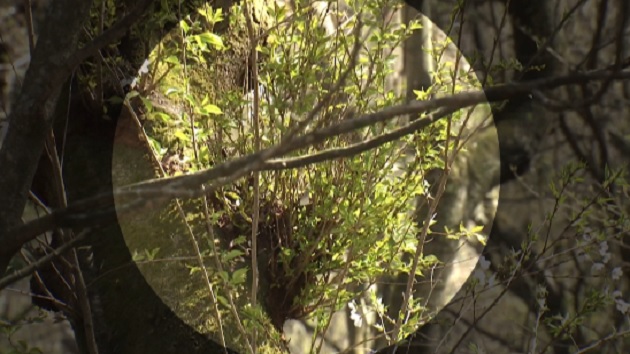
The parent cherry tree of the island’s native species has been diagnosed with an infection of ‘witches’ broom’.
This disease causes deformities in woody plants and a dense mass of shoots resembling a broom has also been spotted in other cherry trees in the area.
While the fate of this natural species is at stake, KCTV News has found in an exclusive report that officials are still busy pointing fingers at one another.
Todd Thacker reports.
[slug] Gwaneumsa campsite
At the Gwaneumsa (관음사) campsite of Hallasan Mountain, branches of a 15-meter-tall cherry tree are covered in lovely pink blossoms.
[slug] Cherry blossoms are still blooming in mid-range Hallasan Mountain
Unlike cherry trees at lower elevations which have bid their flowers farewell, the cherry trees in the mid-range of Hallasan Mountain ? some 600 meters above sea level or higher ? are still blooming.
[slug] Jeju parent cherry tree designated in 2015
This species of cherry tree is known for its superb shape and densely packed petals. It was designated a parent cherry tree native to Jeju in 2015.
However, if you look closely, broom-like masses are developing on its branches.
[slug] Cherry trees deformed by witches’ broom disease
The tree is infected with a fungus, virus or insects that cause witches’ broom.
A neighboring cherry tree also shows symptoms of the disease.
It is assumed that the disease has now spread throughout the area.
[slug] Witches’ broom first diagnosed in 2016
A twig cluster studied in 2016 marked the first confirmation of the disease in Jeju. After the diagnosis, support columns were installed and damaged parts of the parent tree were repaired or removed.
[slug] Jeju Local Heritage No.3 is endangered
But no efforts were made to prevent the spread of this contagious disease, despite its designation as Jeju Local Heritage No. 3.
Kim Gwan-jin / Gwaneumsa Office, Hallasan National Park
The tree has been improperly managed. A dedicated team should be put in charge.
< 김광진 / 한라산국립공원 관음사지소팀장 >
이렇게 빗자루병이 보이는 것으로 봐서 관리가 제대로 되지 않지 않았나 생각됩니다. 전문 부서에서 지속적으로 관리가 필요하다고 생각합니다.
[slug] No vaccine or treatments available, only trimming
Currently there are no vaccines or treatments against witches’ broom. The only way to treat the disease is to physically remove any affected branches.
With the fate of the parent tree hanging in the balance, it remains unclear who is responsible for the management of this native Jeju species.
Kim Gwan-jin / Gwaneumsa Office, Hallasan National Park
The cherry tree is designated the parent tree, but my office only deals with general issues.
< 김광진 / 한라산국립공원 관음사지소팀장 >
기준 어미나무로 지정돼 있고 여기는 일반 관리소이기 때문에..
Song Gwang-pil / Director, Jeju BioResource
It requires 3-4 years of effort to rid of the Witches’ broom.
< 송관필 / 제주생물자원 대표(이학박사) >
자체적으로 건들 수 있는 상황은 아니고, 지속적으로 3~4년은 관리돼야 없앨 수 있다고 봅니다.
[Reporter] Todd Thacker
[Camera] Kim Yong-min
Four years ago this rare species of cherry tree native to Jeju Island was recognized by the province and the Korea Forest Service. With the blight of witches’ broom looming, it remains to be seen who -- if anyone -- will take steps to protect it.
Todd Thacker, KCTV






